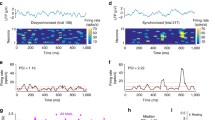Conclusions
-
1.
The number of pairs of neurons of the visual and sensorimotor regions of the cortex working in correlation in rabbits during calm wakefulness is consistently less (35%) than during pseudoconditioning; during pseudoconditioning, the number of such pairs were the same for a presentation of flashes of light in random order accompanied by electrocutaneous stimulation (49%) or for a presentation of sound accompanied by electrocutaneous stimulation (50%). The constant level of pairs functioning in conjugation during calm wakefulness and pseudoconditioning was maintained for the most part by different pairs of cells at different moments in time.
-
2.
During calm wakfefulness as opposted to a CR, the numbers of cross-correlation histograms with broad central peaks indicating the effect of a common source upon the neurons being recorded was fewer.
-
3.
During calm wakefulness and during pseudoconditioning, the number of pairs with up to 120-msec delays in the discharges of neurons of the visual region after those of the sensorimotor region and up to 120-msec delays in the discharges of the sensorimotor region region after the visual were equal.
-
4.
The data obtained on the delays in discharges of neurons during calm wakefulness and pseudoconditioning indicate that a forestalling of the discharges of the neurons of the visual region by discharges of the sensorimotor region are only characteristic of cases when the given regions are the cortical representations of the conditioned and unconditioned stimuli during a CR.
Similar content being viewed by others
Literature cited
É. A. Asratyan, “The two-way connection as a general neurophysiological principle,” Zh. Vyssh. Nervn. Deyat.,31, 1, 3 (1981).
N. P. Bekhtereva, S. V. Medvedev, and E. M. Krol', “Study of the connectivity of distantly located neuronal populations of the human cerebral cortex during the realization of mental activity,” Fiziol. Zh. SSSR,70, 7, 892 (1984).
P. V. Bundzen, N. I. Tsygankov, A. Rotterdam, and E. M. Krol', “Dynamics of the processes of synchronization of distantly located neuronal ensembles,” Fiziol. Cheloveka,7, 3, 541 (1981).
A. K. Gaziev, “Stability of interneuronal connections in the sensorimotor region of the cat,” Zh. Vyssh. Nervn. Deyat.,32, 4, 766 (1982).
T. M. Efremova and V. D. Trush, “Relationship of rhythmic processes in different regions of the cerebral cortex of the rabbit during the action of positive and differential conditioned stimuli,” in: Problems of Spatial Synchronization of Biopotential of the Cerebral Cortex [in Russian], Pushchino-na-Oke (1973).
M. N. Zhadin, A. M. Melekhova, I. Ya. Podol'skii, and G. I. Shul'gina, “Interaction of neurons as a basis for spatial synchronization of EEG,” in: Spatial Synchronization of Biopotential of the Cerebral Cortex [in Russian], Nauka, Moscow (1973).
M. N. Zhadin, Yu. L. Rudnev, and N. N. Prikhod'ko, “Correlational-spectral analysis of spontaneous pulse activity of neurons of the cerebral cortex,” Fiziol. Zh. SSSR,63, 9, 1225 (1977).
V. A. Zosimovskii, “Algorithms of statistical analysis of spontaneous neuronal activity (point processes). P001943. Algorithms and Programs,” Inf. Biol. Far-East Scientific-Research Center, No. 1, p. 35 (1977).
S. V. Karnup and M. N. Zhadin, “Interaction of photoactive cortical neurons during the elaboration of a conditioned defensive response,” Zh. Vyssh. Nervn. Deyat.,30, 5, 971 (1980).
I. N. Knipst, “Spatial synchronization of bioelectrical oscillations in the cortex and several subcortical formations of the cerebral cortex of the rabbit during the elaboration of conditioned reflexes,” in: Modern Problems of Electrophysiology of the Central Nervour System [in Russian], Nauka, Moscow (1967).
A. B. Kogan, N. N. Tkachenko, N. K. Tumasova, and E. L. Shil'ga, “Interconnections of background activity of neurons of the visual and sensorimotor regions of the cortex,” Zh. Vyssh. Nervn. Deyat.,23, 5, 1086 (1973).
G. Kh. Merzhanova and S. A. Varshkevich, “Character of interneuronal connection between the visual and sensorimotor regions of the cortex during the elaboration of conditioned reflexes,” Zh. Vyssh. Nervn. Deyat.,31, 3, 637 (1981).
G. Kh. Merzhanova, S. A. Varshkevich, and V. B. Dorokhov, “Statistical analysis of interneuronal functional connections during the elaboration of conditioned reflexes,” Zh. Vyssh. Nervn. Deyat.,31, 5, 950 (1981).
V. V. Nalimov, Use of Mathematical Statistics in the Analysis of Matter [in Russian], Fizmatgiz, Moscow (1960).
I. V. Pavlova, “Correlation of pulse activity of neurons of various regions of the neocortex of rabbits during switches between positive and inhibitory conditioned reflexes,” Zh. Vyssh. Nervn. Deyat.,36, 1, 58 (1986).
I. V. Pavlova, “Conjugation of unit activity of the visual and sensorimotor regions of the neovortex in rabbits during conditioned reflex to light and sound,” Zh. Vyssh. Nervn. Deyat.,37, 3, 447 (1987).
I. V. Pavlova and V. A. Zosimovskii, “Interaction of neurons of the visual and sensorimotor regions of the neocortex during the elaboration and extinction of a conditioned defensive response,” Zh. Vyssh. Nervn. Deyat.,34, 4, 710 (1987).
I. V. Pavlova and V. A. Zosimovskii, “Types of correlational relationships between neurons of the visual and sensorimotor regions of the neocortex in rabbits,” Zh. Vyssh. Nervn. Deyat.,37, 2, 313 (1987).
Yu. L. Rudnev, “Trace processes of neuronal activity of the cerebral cortex of the rabbit after rhythmic light and electrocutaneous stimulation,” Zh. Vyssh. Nervn. Deyat.,28, 5, 1061 (1978).
Yu. L. Rudnev, M. N. Zhadin, N. N. Prikod'ko, and N. V. Bobkova, “The effect of rhythmic stimulation on the activity of cortical neurons,” Fiziol. Zh. SSSR,63, 10, 1384 (1977).
K. Graham and J. Duffin, “Cross correlation of medullary expiratory neurons in the cat,” Exp. Neurol.,73, 2, 451 (1981).
G. P. Moore, Y. P. Segundo, D. H. Perkel, and H. Levitan, “Statistical signs of synaptic interaction in neurons,” Biophys. J.,10, 9, 876 (1970).
D. H. Perkel, G. L. Gerstein, and G. P. Moore, “Neuronal spike trains and stochastic point interaction in neurons,” Biophys. J.,7, 4, 391 (1967).
Author information
Authors and Affiliations
Additional information
Translated from Zhurnal Vysshei Nervnoi Deyatel'nosti imeni I. P. Pavlova, Vol. 37, No. 5, pp. 850–859, September–October, 1987.
Rights and permissions
About this article
Cite this article
Pavlova, I.V. Conjugation of unit activity in visual and sensorimotor neocortical areas of rabbits during calm wakefulness and pseudoconditioning. Neurosci Behav Physiol 18, 193–201 (1988). https://doi.org/10.1007/BF01149400
Received:
Issue Date:
DOI: https://doi.org/10.1007/BF01149400



